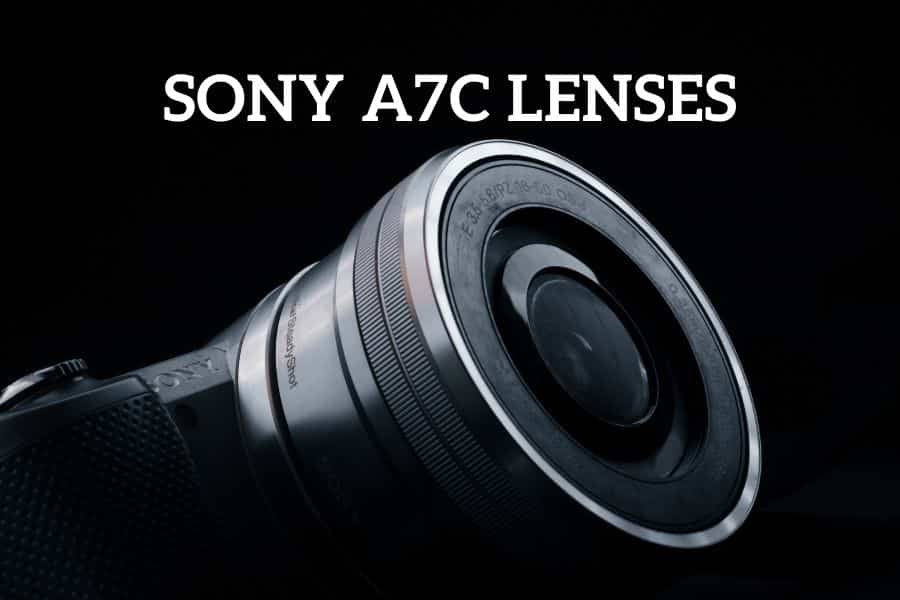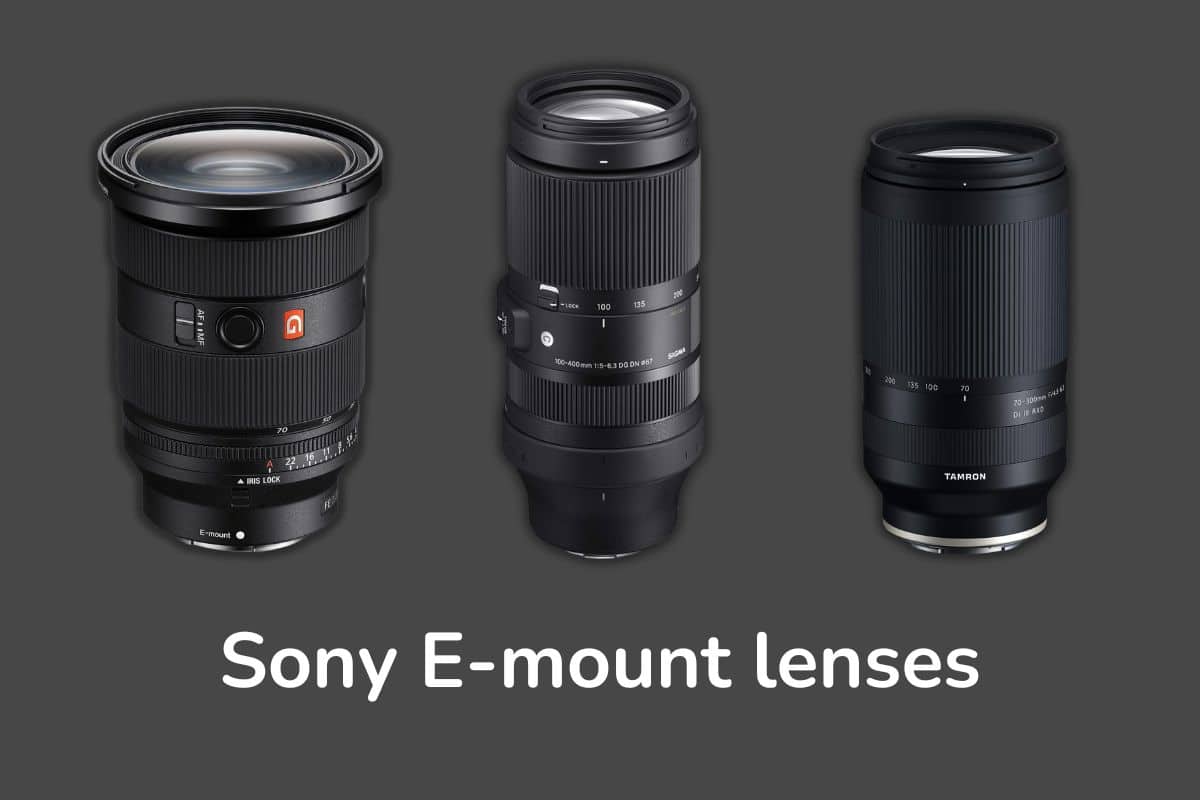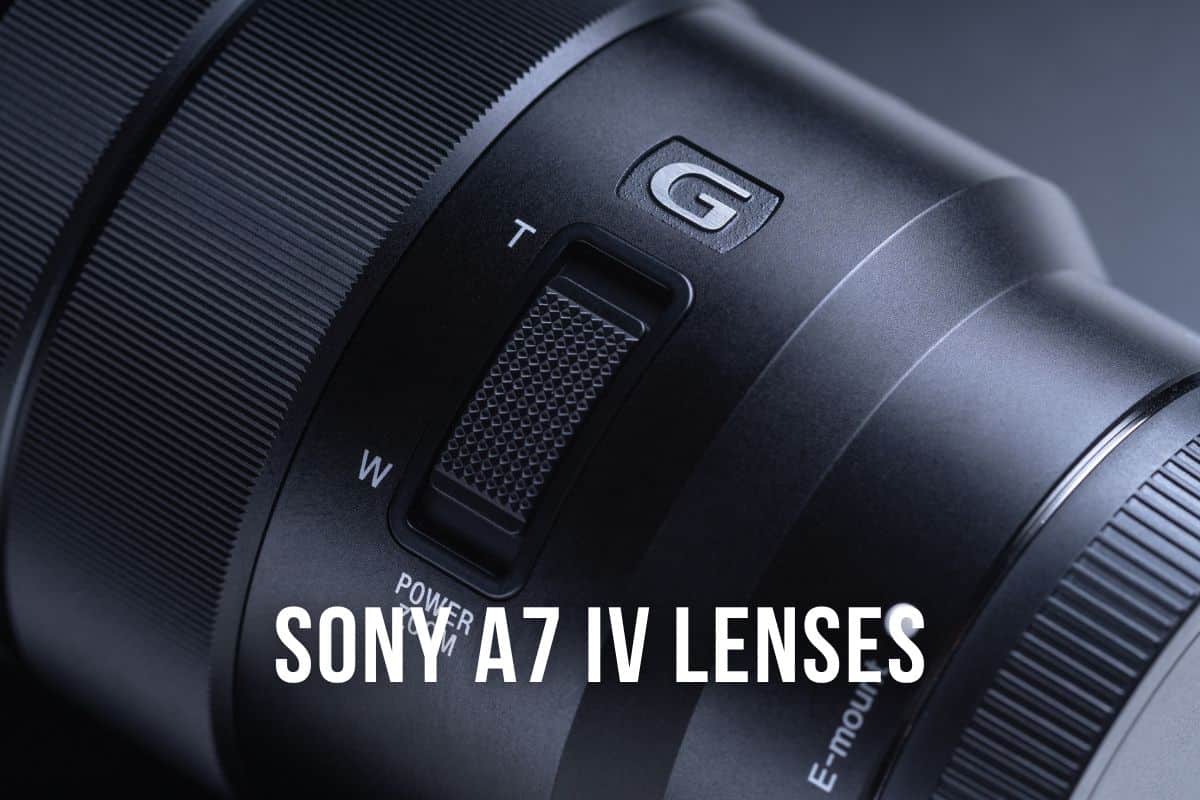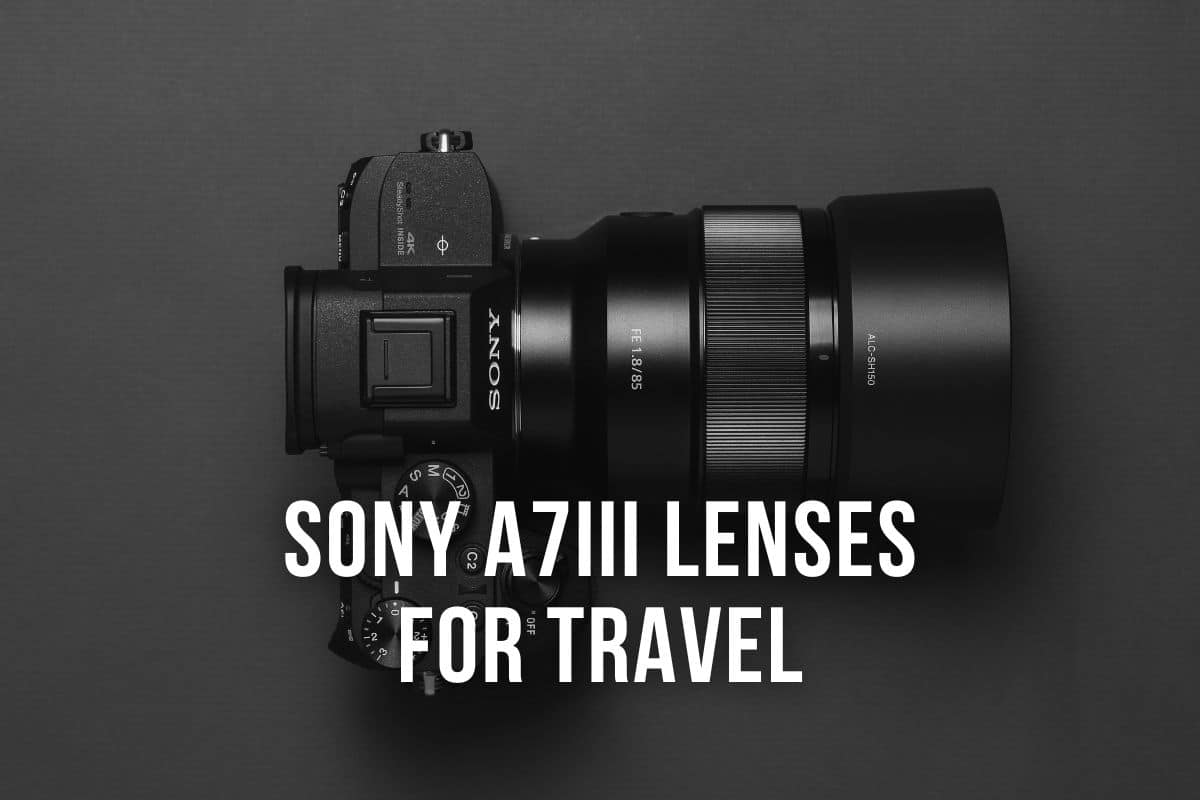Sony a7c is a full-frame camera for more advanced photographers. However, it would also be a camera to choose from if you are still starting, but the aim is to do photography more seriously.
Here we will see what the best lenses for the Sony A7c are. In a list, you will find Sony E-Mount full-frame lenses for travel, portraiture, vlogging, landscape, macro, and other fields of photography.
Read more: How to Choose a Camera Lens That Fits Your Needs.
Disclosure: This article features affiliate links, including Amazon.com. If you decide to buy through one of these links, I’ll earn a small commission at no extra expense to you. For more details, please see my disclosure policy.
What is the best lens for Sony a7c? Foremost, it depends on your aim. Mainly what you want to shoot, your budget, and the qualities you’re looking for.
There are lenses categorized by usage: prime, wide-angle, and different fields of photography. Also, to have a better and quicker aim for the price range, it’s divided into three categories:
- Budget $: 0 – 700
- Average $$: 701 – 1400
- Expert $$$: 1400+
Zoom Lenses
1. Sigma 24-70mm F2.8 DG DN Art
- Price: Average $$
- Dimensions: 4.84 x 3.46 in. / 122.9 x 87.8 mm
- Filter size: Ø82mm
- Weight: 29.5oz. / 835 g
- Maximum aperture: f/2.8
- Focal length: 24 – 70 mm
- Image stabilization: No
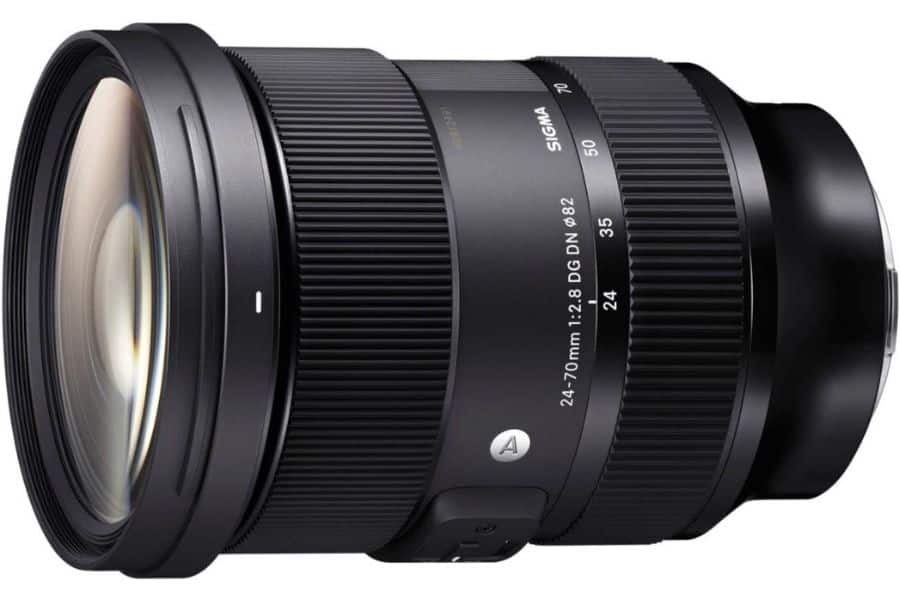
Best Features
+ Silent and fast autofocus
+ Compact and professional design
+ Multipurpose and versatile
+ Weather sealed
Every traveler needs a standard full-frame zoom lens. It handles various photography styles well, from portraits to street scenes. With a focal length of 24-70mm and a maximum aperture of f/2.8, you can’t go wrong with it.
Build and handling: It weighs 29.5 oz. (835 g), which is pretty compact for a large aperture pro-grade Art lens. Also, built-in Super Multi-Layer and Nano Porous Coating are designed into a lens to reduce flare and ghosting, which helps photographers produce rich color and sharp images.
Performance: Large aperture of f/2.8, fast autofocus, and Art performance are some features that will spark every photographer’s eye into the light. It produces excellent photo quality in both low light and high exposure conditions, keeping the colors sharp. However, it lacks image stabilization and relies on in-camera body image stabilization (IBIS).
Best for: It works well on many occasions when you’re shooting, for example, street photography on the go or wandering around hiking trails and taking snaps of landscapes.
Overall, it’s magnificent in any field of photography, and a standard zoom lens like this could be an ideal option for a first lens if you don’t know what to shoot. Deals with portrait and landscape photography with ease.
2. Tamron 28-75mm F/2.8 Di III RXD
- Price: Average $$
- Dimensions: 4.64 x 2.87 in. / 117.8 x 73 mm
- Filter size: Ø67
- Weight: 19.4 oz. / 550 g
- Maximum aperture: f/2.8
- Focal length: 24 – 75 mm
- Image stabilization: No

Best Features
+ All-in-one lens
+ Super lightweight for the zoom lens
+ Fast autofocus and aperture of f/2.8
This lens has the same specifications as the previous one from Sigma. But it’s lighter, has a longer focal length, and is cheaper than the competitor above. This Tamron lens doesn’t have that high-end “Art” touch, but it’s still great to consider.
Build and handling: One thing that makes this Tamron lens an excellent choice is its lightweight design. It’s much lighter than the previous one, giving this lens an advantage. Because everybody wants to travel as light as possible. Overall, the design is simple and compact enough to take it on your travel adventures.
Performance: With specs like an aperture of f/2.8 and fast autofocus, it produces excellent photo quality. A wide aperture with a standard zoom lens is superb for any level photographer. The biggest disadvantage is that it doesn’t have optical image stabilization like the previous Sigma lens. Any minor camera shake is compensated with a Sony camera built-in IBIS.
Best for: With a focal length from 28 to 75mm, it will give you many options to shoot perfect images. Besides travel photography, it’s also ideal for street and landscape photography and efficiently deals with portrait photography.
I would recommend this type of lens for anyone who isn’t exactly sure what they want to shoot. It gives you a great experience to try out different types of photography.
Portrait Lenses
3. Sigma 85mm f/1.4 DG DN Art
- Price: Average $$
- Dimensions: 3.78 x 3.26 in. / 96.1 x 82.8 mm
- Filter size: Ø77
- Weight: 22.0 oz. / 625 g
- Maximum aperture: f/1.4
- Focal length: 85 mm
- Image stabilization: No
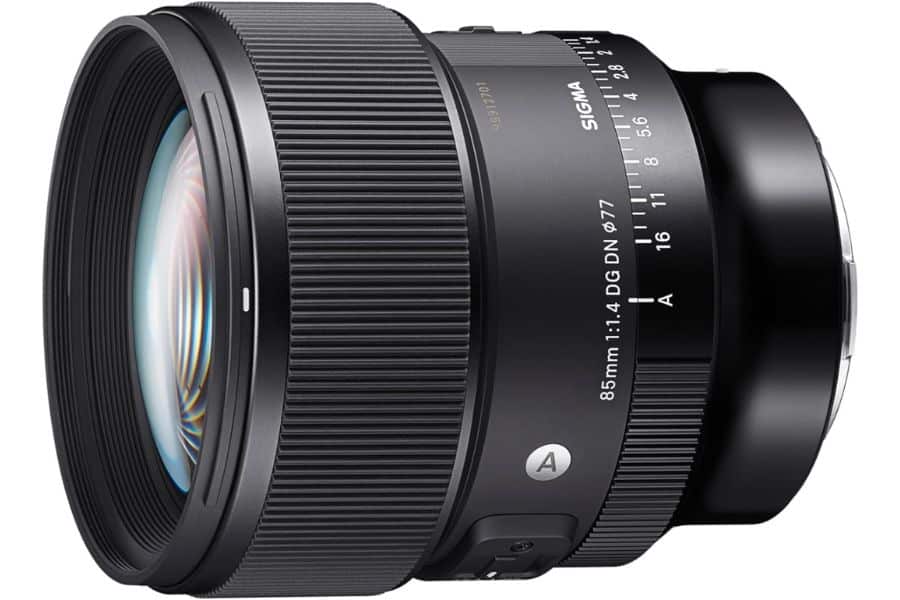
Best Features
+ Excellent bokeh
+ Lightweight and compact for Art lens
+ Produces amazing quality
What would be the best lens for portraits? Is it 85 mm, 50 mm, or even 35 mm? It has been a debate for years, and no real winner exists. One thing is true: this 85mm portrait lens offers some special spark when shooting your model.
Build and handling: The Sigma lens is made of high-quality plastics and a brass mounting plate, which has given it a pretty reasonable weight (22.0 oz. / 625 g) for a pro-grade Art lens. Other lens features are a click-on/off switch, a focus hold button, an aperture lock switch, and an AF/MF switch.
Performance: As you would expect from f/1.4, it’s a fast lens. It produces high-end quality in low light conditions and during high exposure. Another thing is a reliable autofocus system that makes it easy to aim your object razor-sharp within milliseconds.
Best for: As already mentioned, it’s perfect for portrait photography. It has a fantastic soft background and a bokeh effect, which is so special that you haven’t seen it in any prime lens. With an option to adjust the aperture to f/16, it can be easily used and looks excellent even when shooting landscapes.
Overall, the prime lens’s 85mm focal length and aperture of f/1.4 make it one of the best portrait lenses for Sony A7c. If you are into blurred backgrounds and fantastic bokeh, then it’s for you.
4. Sony FE 50mm f/1.2 GM
- Price: Expert $$$
- Dimensions: 4.25 x 3.43 in. / 108 x 87 mm
- Filter size: Ø72
- Weight: 27.5 oz. / 778 g
- Maximum aperture: f/1.2
- Focal length: 50 mm
- Image stabilization: No
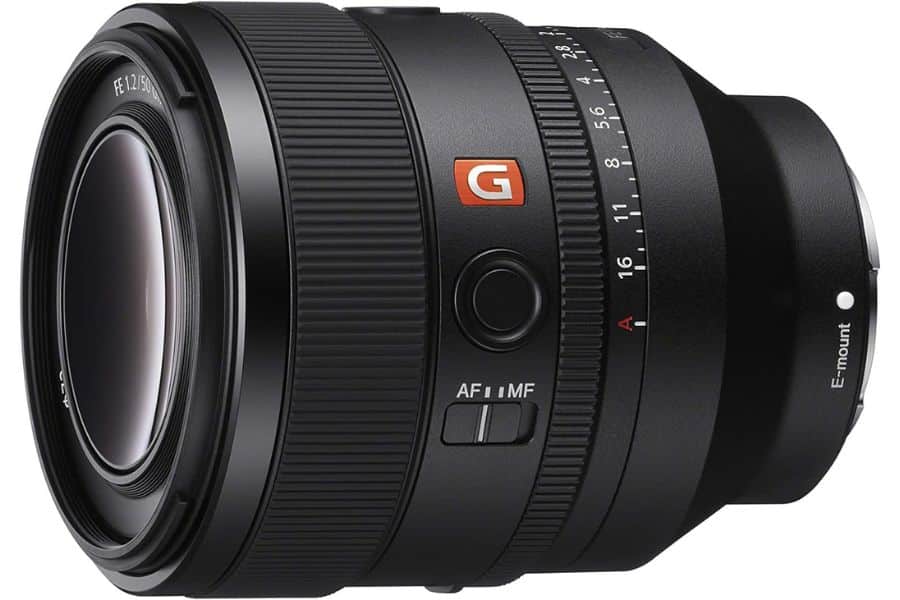
Best Features
+ A super-fast lens
+ Weather-sealed design
+ Razor-sharp details
You don’t see lenses with an aperture of f/1.2 that often. This allows you to shoot in very low light situations, capture motion, and shoot handheld without bumping up ISO. But it all comes with a filthy price.
Build and handling: It is made of quality, pro-grade, weather-sealed materials. There is also an additional button and switch for focusing. There is a built-in Nano AR Coating II to keep down flare and ghosting. The design is also pretty robust and compact. Even the weight isn’t too much for an f/1.2 pro-grade lens.
Performance: Undoubtedly, an ultra-fast aperture is the best feature of this lens. But this is not the only reason it has a heftier price tag: it produces excellent sharp photo quality from center to corner. Also, the good news is that chromatic aberration is minimal.
Best for: It’s mainly used for portraits, but as it has an ultra-wide aperture, you will have many other options for using this pro-grade lens. It’s also great for landscapes, sports, weddings, and product photography.
You will feel and see the difference, which will produce fabulous images. It is excellent in low light, and the bokeh is just unique.
Vlogging Lens
5. Sony FE 20mm f/1.8 G
- Price: Average $$
- Dimensions: 2.89 x 3.33 in. / 73.5 x 84.7 mm
- Filter size: Ø67
- Weight: 13.2 oz. / 375 g
- Maximum aperture: f/1.8
- Focal length: 20 mm
- Image stabilization: No
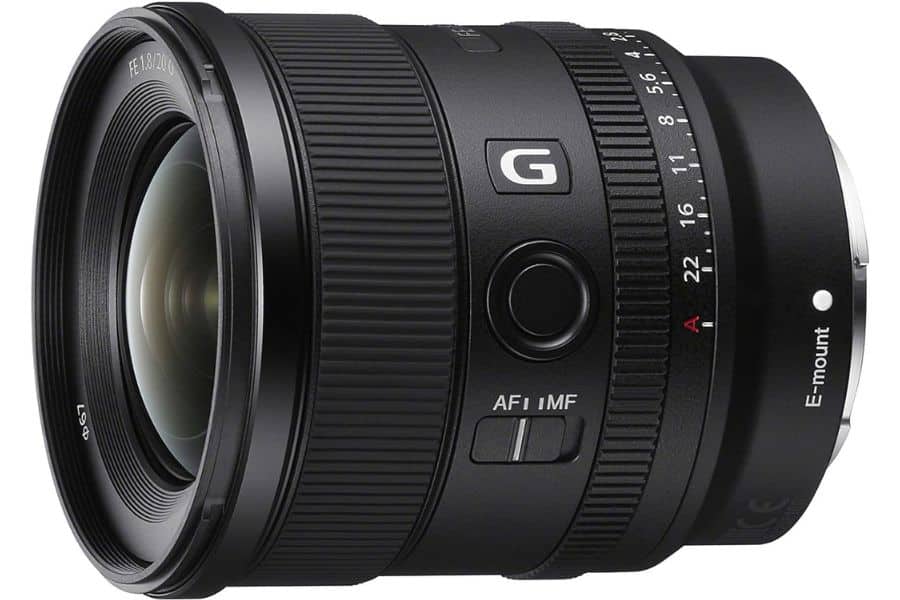
Best Features
+ Ultra wide-angle prime lens
+ Excellent quality
+ Highly versatile
+ Performs well in low light
When choosing the best vlogging lens for your Sony a7c, you must look at a few things. Firstly, as you have to hold the camera for some time, the lighter, the better. Secondly, if you want to capture self-shots (as well as a handheld), the focal length must be short enough to fit you on the frame. These and some other things are well covered with that vlogging lens.
Build and handling: An ultra wide-angle prime lens is compact and lightweight, ideal benefits for any vlogger. At only 13.2 oz. (375 g), you could hold your hand still for some time without any unwanted shake. It also contains a nano AR coating to minimize ghosting and flare. The lens is also designed to be resistant to moisture and dust.
Performance: An aperture of f/1.8 is essential for the vlogger to stand out from the noise with a blurred background. A large aperture also results in it performing well in low-light conditions. A silent focusing system is another feature that will be a massive bonus for any video maker.
Best for: It has a short focal length of 20mm, so you can use it well for short distances, such as street photography, indoor real estate photography, or shooting wide-angle landscapes. It’s a versatile lens with comprehensive options to create something unique.
It’s perfect for both videos and photos and is a highly versatile lens with quiet autofocus, a large aperture, and excellent sharpness throughout the range.
Prime Lenses
6. Sony FE 135mm F1.8 GM
- Price: Expert $$$
- Dimensions: 3.52 x 5 in. / 89.5 x 127 mm
- Filter size: Ø82
- Weight: 33.5 oz. / 950 g
- Maximum aperture: f/1.8
- Focal length: 135 mm
- Image stabilization: No
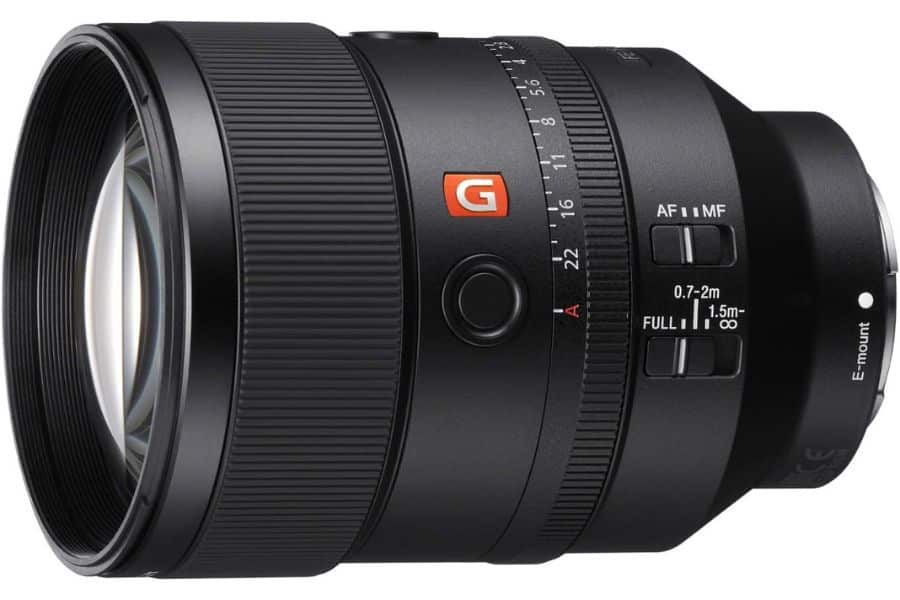
Best Features
+ High quality and contrast
+ A large aperture and fast autofocus
+ Excellent shallow depth of field and bokeh
A 135mm prime lens is a more likely rarity, and it’s used mainly by professionals who want to add other perspectives to their captures. This Sony E-mount lens is unique and will add new dimensions and spark. But it all comes with a price, as it’s pretty expensive.
Build and handling: As it’s a large telephoto prime lens, the weight of 33.5 oz. (950 g) wouldn’t come as a surprise. It also includes Nano AR Coating, which will reduce ghosting and flare. Overall, it’s designed from quality materials that are also weather-sealed.
Performance: Regarding image quality and sharpness, it’s among the best in the field. An aperture of f/1.8 and a focal length of 135mm result in high contrast and details throughout the image. It’s also outstanding in low-light conditions and makes objects stand out from the background.
Best for: This 135mm lens is mainly used for portraits, as it gives a very shallow depth of field with excellent bokeh. But you also use it for weddings, sports, landscapes, or even detailed street photography.
The price tag could scare you off, but you will get magnificent quality in exchange. This pro-grade tool will level up your game if you are in the portrait photography business.
7. Sony FE 50mm f/2.5 G
- Price: Budget $
- Dimensions: 2.7 x 1.8 in. / 68 x 45 mm
- Filter size: Ø49
- Weight: 6.1 oz. / 174 g
- Maximum aperture: f/2.5
- Focal length: 50 mm
- Image stabilization: No
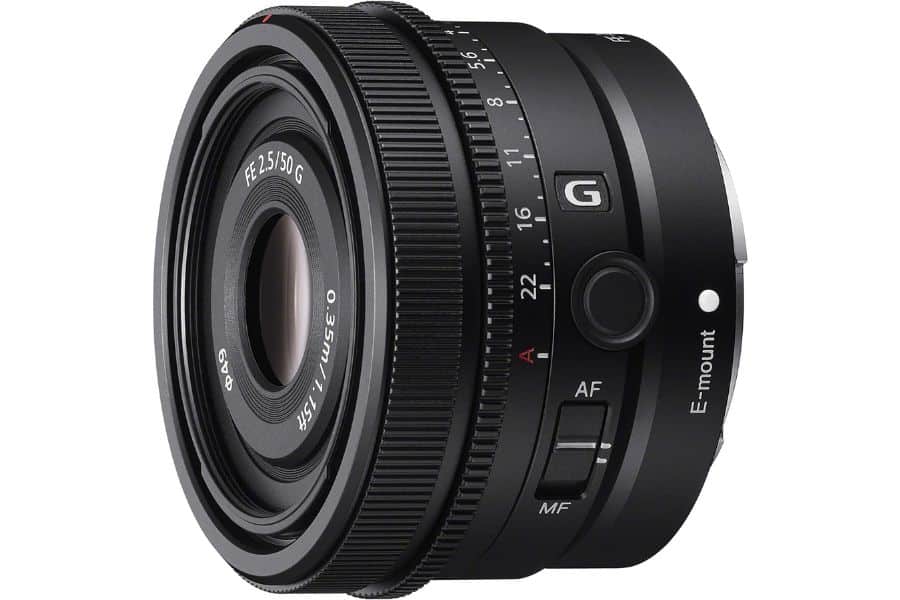
Best Features
+ Very affordable
+ Compact and lightweight
+ Low distortion
It’s a standard prime lens that is exceptional for its compact design. Despite the low weight and price, it’s still considered a high-quality tool for your camera gear that will do wonders on your images.
Build and handling: One of the biggest advances of this lens is that it weighs only 6.1 oz (174 g). It’s incredibly lightweight for a quality lens. The all-metal exterior design is also moisture and dust-sealed. You will also find an aperture ring on the lens and a click and switch for focusing. Aspherical elements help minimize distortions and chromatic aberrations to capture beautiful images.
Performance: You shouldn’t judge its value by size because it produces fabulous quality despite its dimensions. Even though an aperture of f/2.5 isn’t the best indicator for a 50mm prime lens, it’s still decently fast and performs well in low-light situations.
Best for: As it’s a prime lens, you would assume it’s more likely a portrait lens. To be true, it’s used in many ways: events, weddings, landscapes, or even product photography. Due to its compact design, it’s also ideal for traveling as it doesn’t occupy much space in a bag.
It’s one of the most affordable lenses for the Sony A7c, and it still produces excellent quality. The quality, size, and price range are exceptionally bargain for a beginner, and you would win a lot if you have this in your camera gear.
Wide Angle Lenses
8. Sony – FE 16-35mm F2.8 GM
- Price: Expert $$$
- Dimensions: 3.48 x 4.79 in. / 88.5 x 121.6 mm
- Filter size: Ø82
- Weight: 24 oz. / 680 g
- Maximum aperture: f/2.8
- Focal length: 16-35 mm
- Image stabilization: No
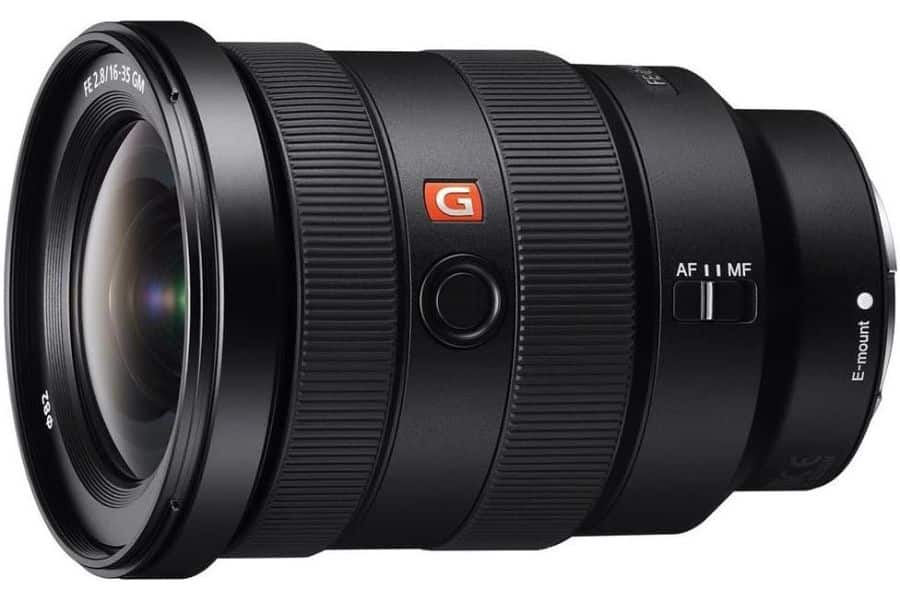
Best Features
+ Weather-sealed materials
+ Quick autofocus with f/2.8
+ Wide-angle coverage
An ultra-wide lens is another piece from the G Master series that sparks with high-quality specs. There are many benefits that make it a high-grade lens, but the price tag isn’t one of them. However, if you want something special, look nowhere else.
Build and handling: Its focal lengths from 16 to 35mm give you more versatile options to shoot close range and zoom out more than usual with wide-angle lenses. The materials used are also high quality, with weather-sealing components included. There’s also a focus switch and a hold button on the lens.
Performance: As usual for G Master series lenses, it produces excellent image quality throughout every focal length. Autofocus Dual DDSSM systems give it rapid speed with silent focusing. After all, contrast and sharpness are spectacularly impressive when considering image quality.
Best for: As it has wide-angle capabilities, it’s primarily used in close-range photography where you also need to fit a lot of objects or people. For example, it works perfectly for group photos, events, weddings, or street photography.
It’s an expensive lens, but its flawless performance increases the price. You won’t find any other options if the high image quality is essential for you.
9. Sigma 14-24mm F/2.8 DG DN Art
- Price: Average $$
- Dimensions: 3.35 x 5.16 in. / 85 x 131 mm
- Filter size: Rear holder
- Weight: 28.04 oz. / 795 g
- Maximum aperture: f/2.8
- Focal length: 14-24 mm
- Image stabilization: No
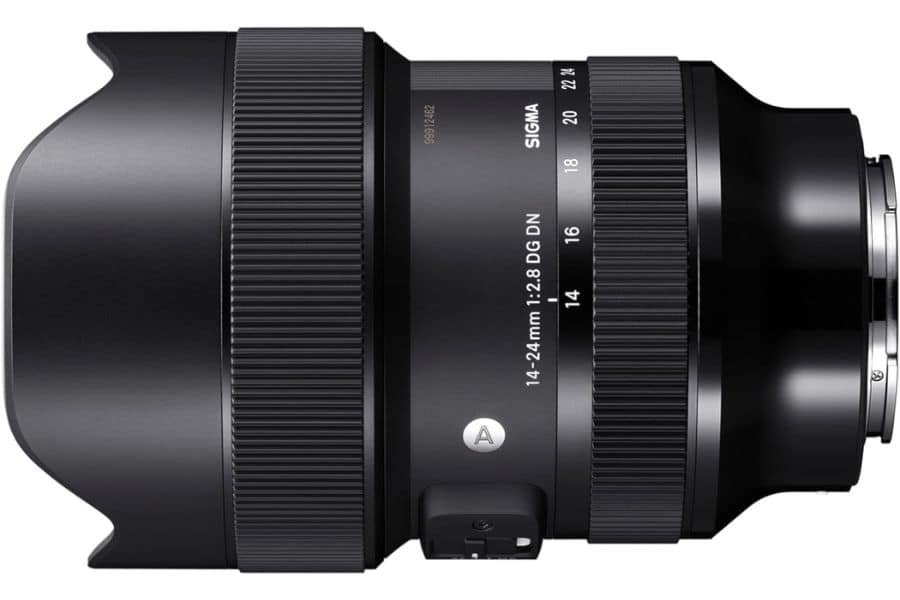
Best Features
+ A wide viewing angle
+ Flawless contrast and sharpness
+ Weather sealed
This Sigma lens will be a great alternative, almost double as cheap as the previous one. It offers excellent image quality with nearly the exact specifications, like the aperture 2.8. However, there is a slight difference in focal lengths compared to the previous.
Build and handling: It weighs 28.04 oz. (795 g), which could be a bit too much when shooting handheld for extended periods. Built-in HyperSonic Motor autofocus also gives faster and more silent focusing capabilities. Also, it includes a multi-layer coating to reduce flare and ghosting.
Performance: Sigma Art lenses are known for their superior image quality, and this one is no exception. It also rocks with contrast and sharpness throughout the entire zoom range. Thanks to the aperture f/2.8, it performs well in low-light photography situations.
Best for: Most notably, it’s used at events, architecture, city, real estate, or any other photography type where you have tight space. Due to its wide viewing angle, capturing panoramic landscape photos is also great.
Overall, it’s an excellent choice in terms of quality and price ratio. It has a bit lower specifications than the previous Sony lens, but when you are looking for a pro-grade wide-angle lens, then it does work.
10. Tamron 17-28mm f/2.8 Di III RXD
- Price: Average $$
- Dimensions: 2.87 x 3.9 in. / 73 x 99 mm
- Filter size: Ø67
- Weight: 14.82 oz. / 420 g
- Maximum aperture: f/2.8
- Focal length: 17-28 mm
- Image stabilization: No
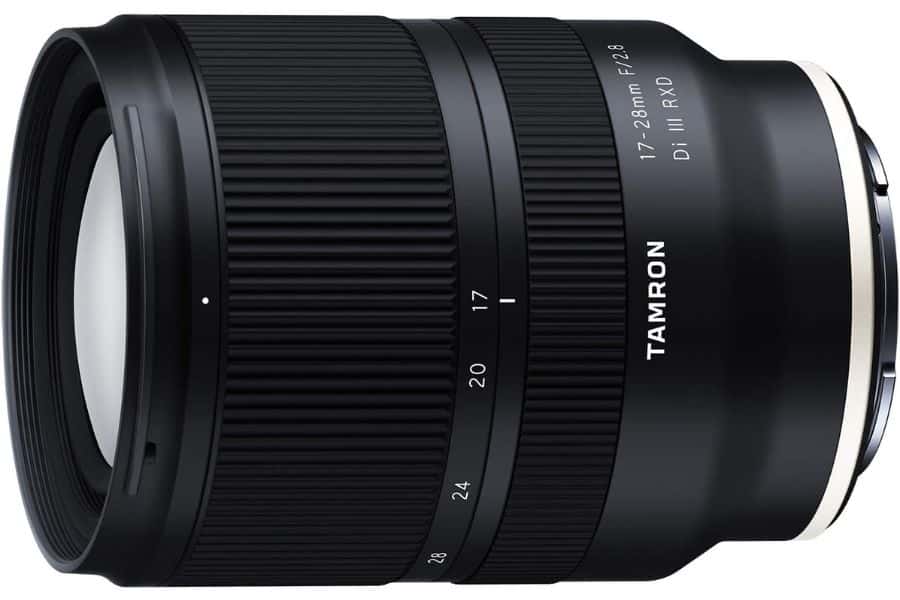
Best Features
+ Lightweight design
+ Fast autofocus
+ Affordable price
The cheapest alternative compared to previous wide-angle Sony a7c lenses listed above. Third-level company Tamron lens has almost the same benefits as competitors, which also even have some advantages over the Sony and Sigma lenses.
Build and handling: It weighs only 14.82 oz. (420 g) and it’s much smaller than previous competitors. Chiefly plastic is used throughout the lens (with a metal mount), which looks and feels more like consumer-level gear. However, due to that, it weighs much less than its competitors but offers the same performance.
Performance: A combination of fast aperture (f/2.8), zoom, and lightweight design is a more likely rarity. Also, the solid image quality remains in place throughout the zoom range. As it’s named a consumer lever lens, its performance is excellent.
Best for: Like other wide-angle lenses, it is mainly used in tight spaces. Its aperture of f/2.8 makes it perfect for indoor photography without much light. So it’s ideal for events, real estate, product photography, or anything else that needs to fit many subjects into one frame.
Compared to previous competitors, it’s much lighter and cheaper, so in terms of quality and price, it’s an excellent choice for wide-angle lenses.
Telephoto Lens
11. Sony FE 70-200mm F2.8 GM OSS II
- Price: Expert $$$
- Dimensions: 3.46 x 7.87 in. / 88 x 200 mm
- Filter size: Ø77
- Weight: 36.9 oz. / 1045 g
- Maximum aperture: f/2.8
- Focal length: 70-200 mm
- Image stabilization: Yes
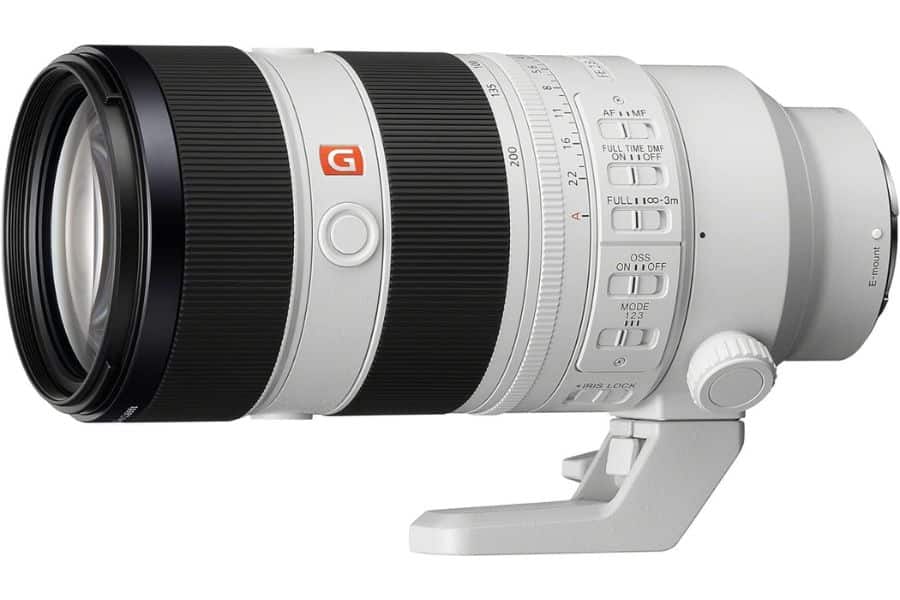
Best Features
+ Aperture of f/2.8
+ Pretty reasonable weight for a telephoto
+ Optical image stabilization
It’s the best telephoto zoom lens for Sony E-mount and has many benefits. It’s an on-demand lens, and it even has a waiting list. It’s an upgrade from a previous model, approximately 30% lighter than the first version.
Build and handling: An upgraded lens’s key feature is its quality build-up. Thanks to its aluminum alloy body, it weighs 36.9 oz (1045 g). It’s highly lightweight for this kind of pro-grade telephoto lens. But most importantly, it has optical stabilization (5-axis Optical SteadyShot). Also, the newest version, Nano AR Coating II, is built to minimize flare and ghosting.
Performance: Another key feature of this Sony lens is its large aperture. You won’t find many telephoto zoom lenses with a fast maximum aperture of f/2.8. It results in fast autofocus and excellent performance during low-light situations.
Best for: You would benefit most from using it in nature, like landscapes and wildlife photography. Due to its fast autofocus and long focal lengths, it can also be used in sports.
It will be a real investment if you do it professionally and want to shoot high-quality images (with optical stabilization).
Budget Lenses
12. Sony 16-50mm f/3.5-5.6 OSS
- Price: Budget $
- Dimensions: 2.55 x 1.18 in. / 64.77 x 29.97 mm
- Filter size: Ø40.5
- Weight: 4.1 oz. / 116 g
- Maximum aperture: f/3.5
- Focal length: 16-50 mm
- Image stabilization: Yes
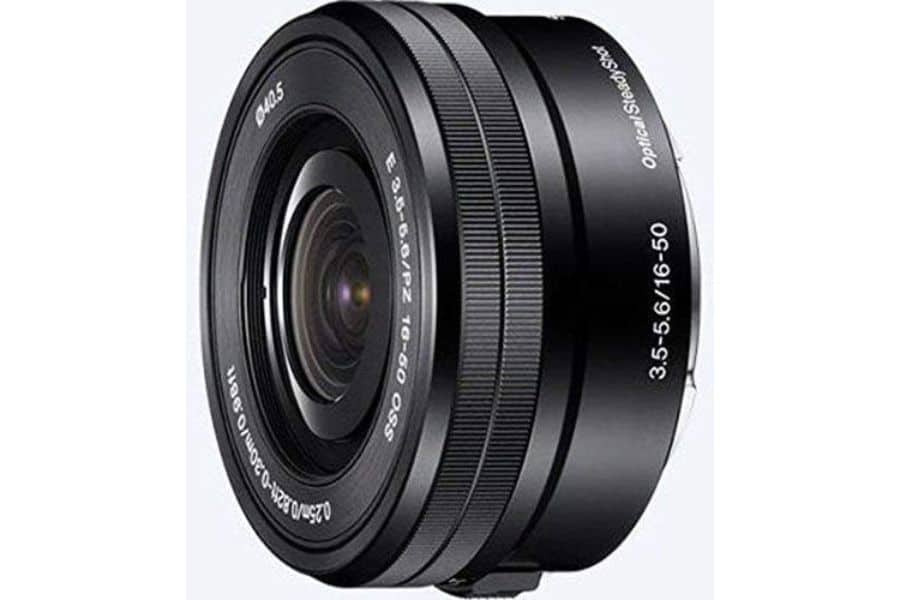
Best Features
+ Extra affordable
+ Super lightweight zoom lens
+ Small dimensions
It’s one of the smallest options for Sony E-mount. It usually comes together as a kit lens, but if not, then this investment should be considered by hobby photographers.
Build and handling: As already mentioned, its most significant advantages are its dimensions and weight. Looks almost like a pancake lens, but it will double the length after it is zoomed out. Thanks to its compact design, you can carry it almost everywhere – in a bag or even in a pocket (if you have deep pockets). You don’t especially need a camera bag when you only carry this lens together with the camera.
Performance: Interestingly, it has built-in image stabilization. Also, it has other usual features like smooth autofocus and ED glass for reduced aberrations. However, the focus could be a bit too noisy for videos.
Best for: A wide-angle lens could be an ideal partner for your travel adventures if you have limited space and budget. It performs well and can be used in street and landscape photography.
It’s ridiculously affordable and would be a decent investment for a hobby photographer.
13. Sony 28mm F/2.0
- Price: Budget $
- Dimensions: 2.52 x 2.36 in. / 64 x 60 mm
- Filter size: Ø49
- Weight: 7.05 oz. / 200 g
- Maximum aperture: f/2.0
- Focal length: 28 mm
- Image stabilization: No
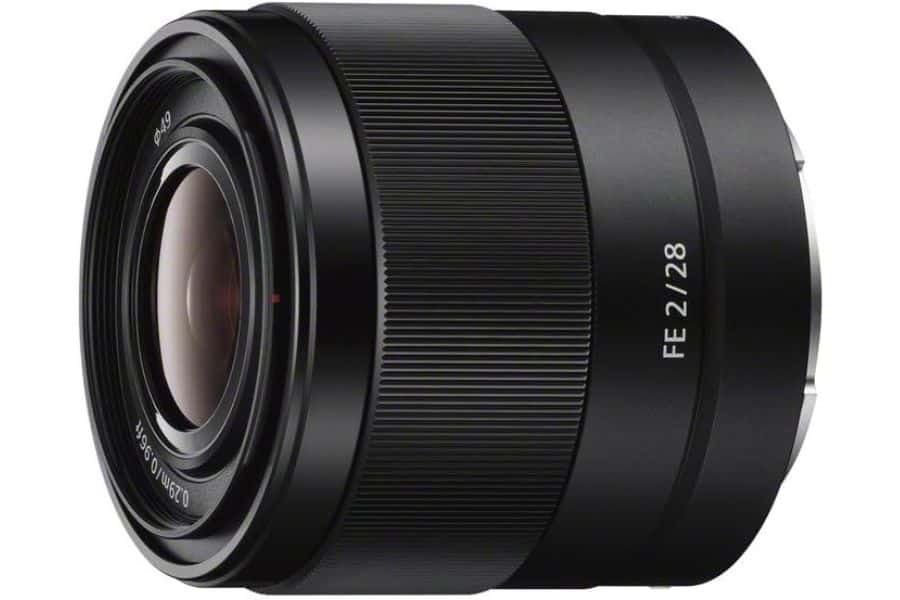
Best Features
+ Compact and quality design
+ Fast aperture
+ Excellent image quality
A small and fast lens is a bit of an upgrade to the previous one. Specifically, it’s a prime lens with a decent aperture. A budget lens is an excellent deal for a beginner photographer.
Build and handling: It’s surprisingly lightweight for a fast prime lens. The overall build of the lens looks and feels professional, with an aluminum alloy body. It’s also moisture and dust-resistant.
Performance: The greatest perk of this lens is the aperture of f/2.0. Fast and silent autofocus will perform well in difficult situations like low light conditions. Also, the image quality is exceptional, with contrasting colors.
Best for: A prime lens with a focal length of 28mm is not widely used. Some say it’s too narrow for wide-angle snaps and too wide for anything else. But it depends on the photographer and how they can get the best out of a current lens. It’s still great for landscapes, portraits, capturing details from nature, etc.
This is a good fit for your camera gear if you are looking for a fast lens and proper image quality without breaking the bank.
Travel Lens
14. Sony FE 24-105mm F4 G OSS
- Price: Average $$
- Dimensions: 3.28 x 4.46in / 83.4 x 113.3 mm
- Filter size: Ø77
- Weight: 23.36 oz. / 663 g
- Maximum aperture: f/4
- Focal length: 24 – 105 mm
- Image stabilization: Yes
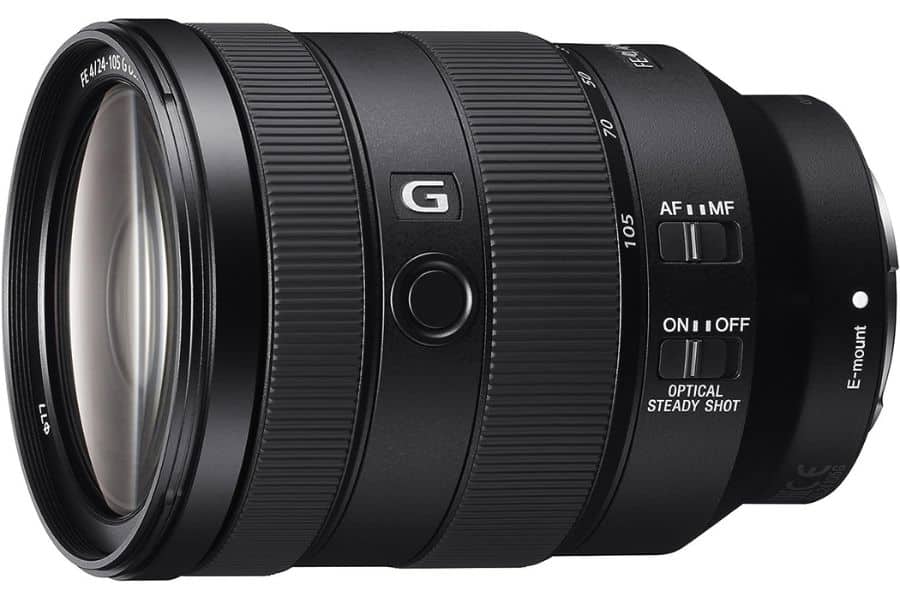
Best Features
+ Contains built-in image stabilization
+ Amazing price and quality ratio
+ Pretty lightweight for handheld shootings
When you see it’s from the G series – it already sounds professional. Suppose you are more than a hobby photographer who uses a camera often. It should be in your camera gear because it offers much value in different photography areas.
Build and handling: Made with quality materials, you wouldn’t expect less. The aluminum body gives it a pretty decent weight of 23.36 oz. (663 g), which is typical for this wide-angle pro-grade lens. Its dust and moisture resistance includes Nano AR and fluorine coatings, among many other benefits.
Performance: A maximum aperture throughout the zoom range gives you great control over focusing and an excellent background shallow depth of field. Super Sonic autofocus gives you traditionally as it’s with G-series a fast, quiet, and smooth focusing. But the biggest perk of this lens is built-in image stabilization.
Best for: A wide-angle zoom lens is ideal for everyday shooting. It never lets you down and can handle different situations. You can take it on your travels when you are big on Instagram, for example, or on a simple day out with only a lens. So a wide-angle street capture, a quick portrait, or taking that nice nature photo far away – will handle these situations excellently.
Overall, it’s one of the best lenses for Sony a7c, and even the price isn’t something that will scare photographers away.
Macro Lens
15. Sigma 105mm f/2.8 DG DN Macro Art
- Price: Average $$
- Dimensions: 2.9 x 5.3 in / 74 x 135.6 mm
- Filter size: Ø62
- Weight: 25.6 oz. / 710 g
- Maximum aperture: f/2.8
- Focal length: 105 mm
- Image stabilization: No
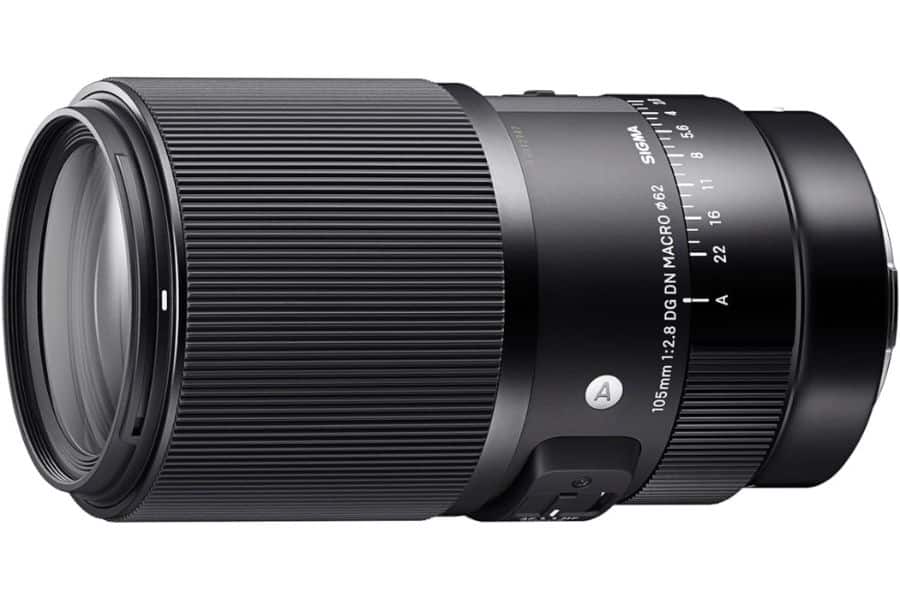
Best Features
+ Weather-sealed build
+ The focal length of 105 mm
+ Great aperture
If you are into taking captures of insects, spiders, flowers, or anything else that’s super small, then look nowhere else. You won’t find any better macro with several benefits for this affordable price.
Build and handling: This Sigma macro lens is built with weather-sealed materials. This gives it a professional look and an excellent grip. As customary, it has a Super Multi-Layer coating for reducing flare and ghosting, which rewards in better contrast.
Performance: With the aperture f/2.8, it will do a fantastic job. Produces high-quality, detailed images with soft backgrounds. Also, a hypersonic motor gives you fast and quiet focus.
Best for: There’s no question that it’s meant for macro photography. With a 105mm focal length, you will benefit for many reasons. First, you don’t need to be too close to objects that could be scared off (like insects). Secondly, your captures wouldn’t be ruined because of the shade from your lens; you can shoot at a distance.
Overall, you wouldn’t find any greater deal for this camera in terms of macro photography. A focal length of 105mm, aperture of 2.8, and a hypersonic motor already say everything.
Conclusion
Here was a review of the best lenses for the Sony a7c. Hopefully, you found a good piece of information, and now you’re sure what your next lens is. The lenses mentioned above would upgrade your photography, but remember to practice your skills.
PIN IT
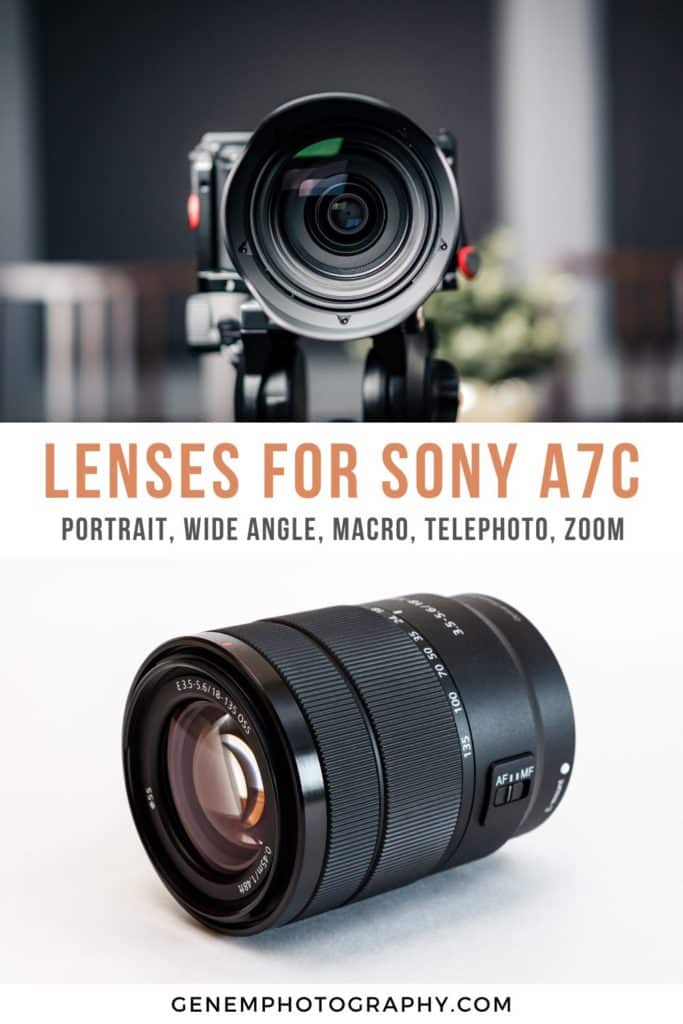

Recent posts:
